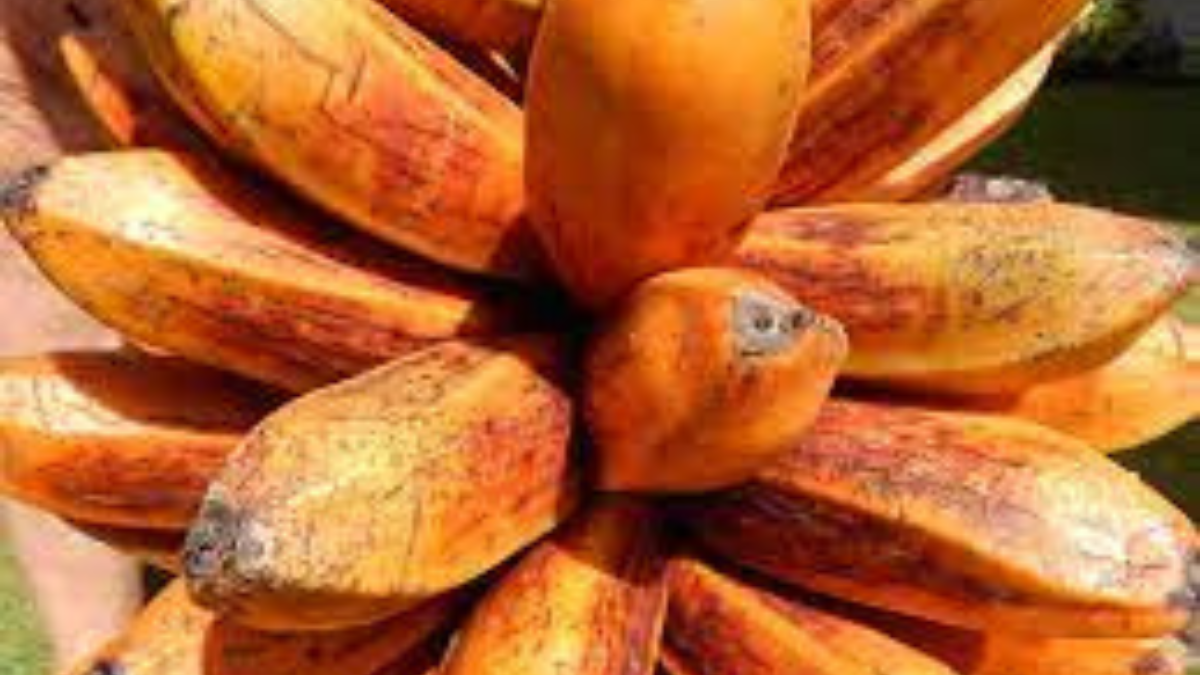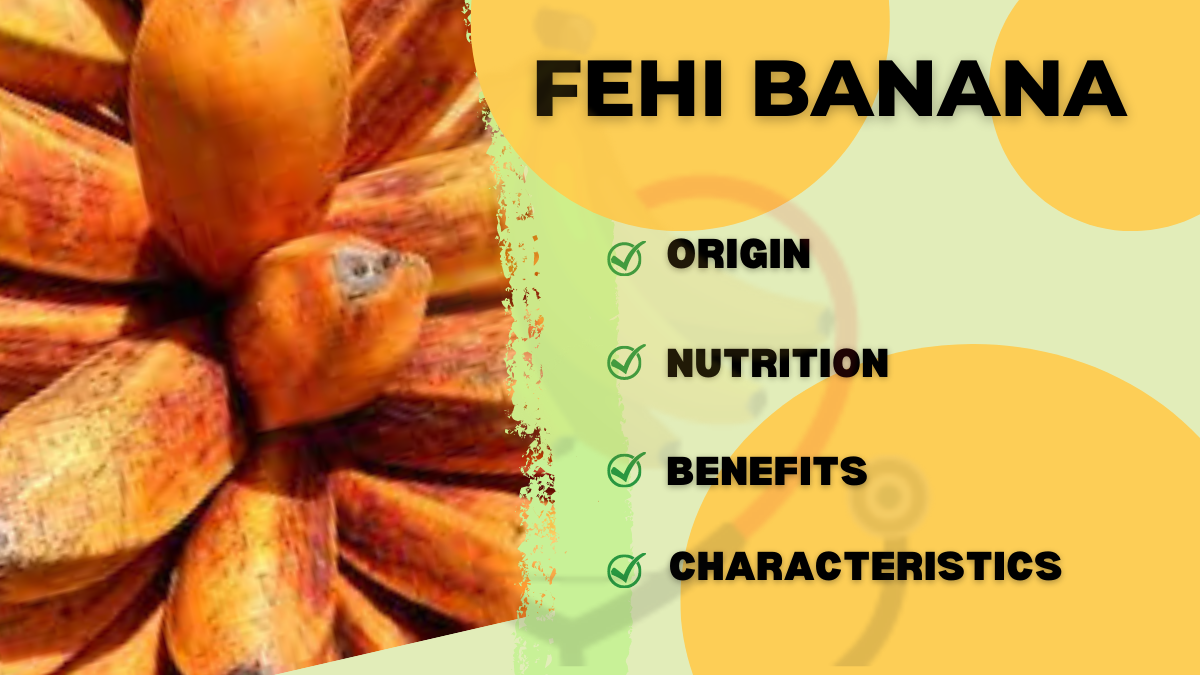Fehi bananas, also known as “red bananas” or “Fe’i,” are a unique variety of bananas that grow in the Pacific Islands and Southeast Asia. [1]
Unlike the common yellow Cavendish banana, Fehi bananas are smaller in size, have a reddish-purple skin, and a sweeter flavor. They are usually consumed raw, but they can also be cooked or used in desserts.
In this article, we’ll explore the fascinating world of Fehi bananas and why they’re worth trying.
Origins of Fehi Banana
The Fehi Banana, also known as “Musa Troglodytarum,” is believed to have originated in the Pacific Islands, particularly in the region of Tahiti. It is an ancient fruit with a rich history dating back thousands of years. Over time, it spread to various tropical regions worldwide, including Hawaii, Fiji, and parts of Southeast Asia.

Appearance and Taste
Fehi Banana stands out from other banana varieties due to its unique appearance. The fruit is shorter and plumper, with a vivid green skin when unripe, turning to a rich golden-yellow when fully ripe. Its flesh is soft, creamy, and exudes a delightful aroma that adds to the overall experience of consuming this tropical delicacy.
In terms of taste, Fehi Banana delights the taste buds with a perfect balance of sweetness and subtle tanginess. Its flavor profile offers a hint of tropical paradise, making it a favorite among both locals and travelers.
Where do Fehi bananas grow?
Fehi bananas are native to the Pacific Islands, including Samoa, Tonga, and Fiji, but they can also be found in other parts of Southeast Asia, such as Papua New Guinea and Vanuatu. They thrive in tropical and subtropical climates and are typically grown in small farms or home gardens.
Nutrition of Fehi Banana
The following information provides an approximate nutritional breakdown of Fehi bananas (per 100 grams):
- Calories: 96 kcal
- Carbohydrates: 22.8 grams
- Sugars: 17.2 grams
- Dietary Fiber: 2.6 grams
- Fat: 0.2 grams
- Protein: 1.2 grams
- Potassium: 358 mg (10% of the recommended daily intake)
- Vitamin C: 8.7 mg (10% of the recommended daily intake)
- Vitamin B6: 0.4 mg (25% of the recommended daily intake)
Health benefits of Fehi bananas
Incorporating Fehi Banana into your diet can yield several health benefits.
1: Improved Digestive Health
The high fiber content in Fehi Banana aids in promoting healthy digestion and preventing gastrointestinal issues such as constipation. [2]
2: Enhanced Heart Health
Potassium, a crucial nutrient found in Fehi Banana, supports heart health by regulating blood pressure and reducing the risk of cardiovascular diseases. [3]
3: Boosted Immunity
The presence of vitamin C and antioxidants strengthens the immune system, helping the body fend off infections and illnesses. [4]
4: Increased Energy Levels
Fehi Banana serves as an excellent energy booster, making it a perfect snack option for active individuals and athletes. [5]
5: Mood Enhancement
This tropical fruit contains compounds that may positively influence mood and promote a sense of well-being. [6]
Characteristics of Fehi banana
The Fehi banana is a variety of banana that has specific characteristics distinguishing it from other varieties. Here are some characteristics of the Fehi banana:
Size: Fehi bananas are generally larger in size compared to other banana varieties. They can grow up to 9 inches (23 centimeters) in length.
Color: When fully ripe, Fehi bananas have a vibrant yellow color, similar to other common banana varieties.
Flavor: The Fehi banana has a sweet and tangy flavor with a hint of citrus. It is known for its pleasant taste, making it a popular choice for eating fresh.
Texture: The texture of Fehi bananas is smooth and creamy, similar to other dessert bananas. They have a soft and tender flesh that is easy to bite into.
Shelf Life: Fehi bananas have a relatively long shelf life compared to some other banana varieties. When stored properly, they can stay fresh for a longer period.
Cooking and Baking: The Fehi banana is versatile and can be used in various culinary preparations. It can be eaten fresh, sliced into salads, blended into smoothies, or used in baking recipes like banana bread or muffins.
Popular Fehi banana recipes
There are many ways to use Fehi bananas in recipes. Here are a few popular ones:
Fehi banana pancakes: Mix mashed Fehi bananas with flour, milk, and eggs to make a sweet and fluffy pancake batter. Serve with maple syrup and butter.
Fehi banana smoothie: Blend Fehi bananas with coconut milk, honey, and ice for a refreshing and healthy smoothie.
Fehi banana fritters: Mix sliced Fehi bananas with flour, sugar, and baking powder to make a batter. Deep fry in hot oil until golden brown and serve as a snack or dessert.
Fehi bananas are a tropical delight that is worth exploring. Not only are they delicious and versatile, but they also offer a range of health benefits.
Fehi Banana, with its delightful taste and impressive nutritional profile, is truly a tropical treasure. Whether you enjoy it fresh, blended into smoothies, or incorporated into various recipes, this fruit offers a range of health benefits while tantalizing your taste buds.
FAQs
Are Fehi bananas genetically modified?
No, Fehi bananas are a naturally occurring variety of bananas and are not genetically modified.
Can Fehi bananas be used in baking?
Yes, Fehi bananas can be used in baking, particularly in recipes that call for mashed bananas such as banana bread or muffins.
How do Fehi bananas differ from other types of bananas?
Fehi bananas are smaller in size, have a reddish-purple skin, and a sweeter flavor compared to other types of bananas.
Are Fehi bananas more expensive than other bananas?
Because Fehi bananas are not widely available outside of their native regions, they may be more expensive than other types of bananas in some areas.
Can Fehi bananas be frozen?
Yes, Fehi bananas can be frozen for later use in recipes or smoothies. Simply peel and slice the bananas before placing them in a freezer-safe container.

